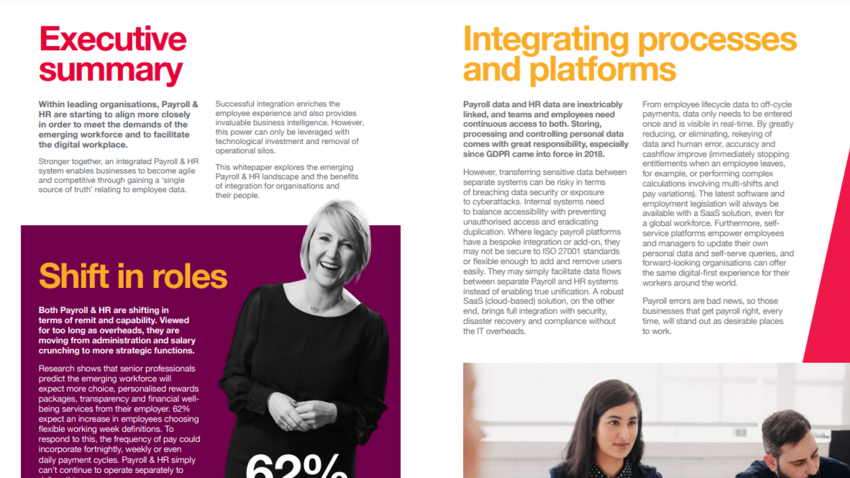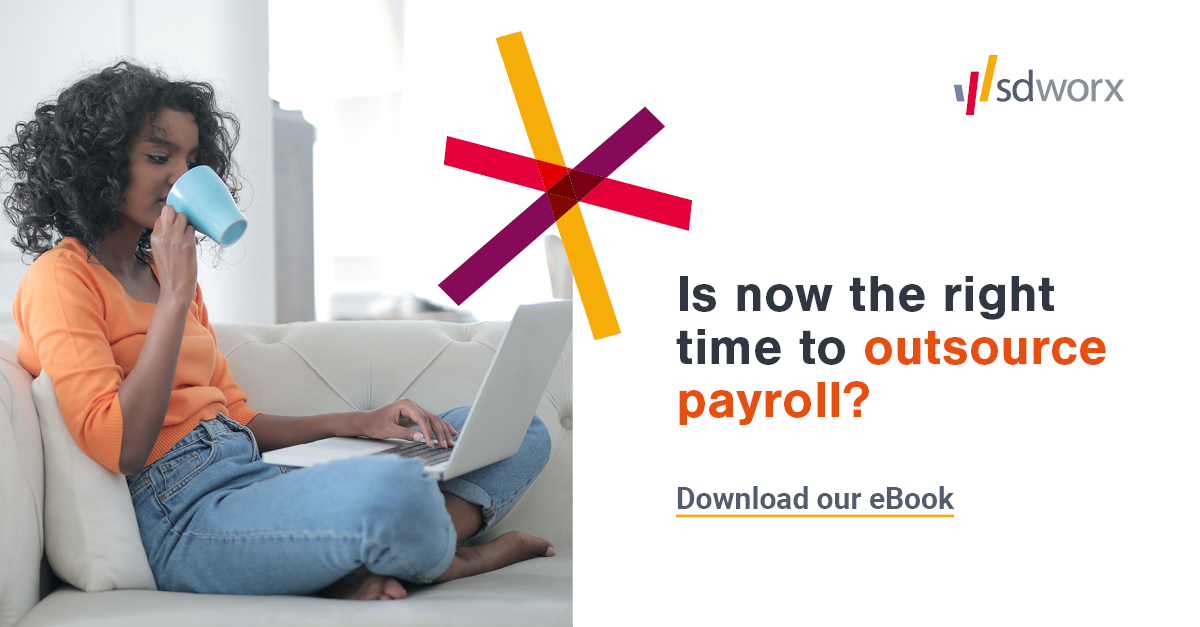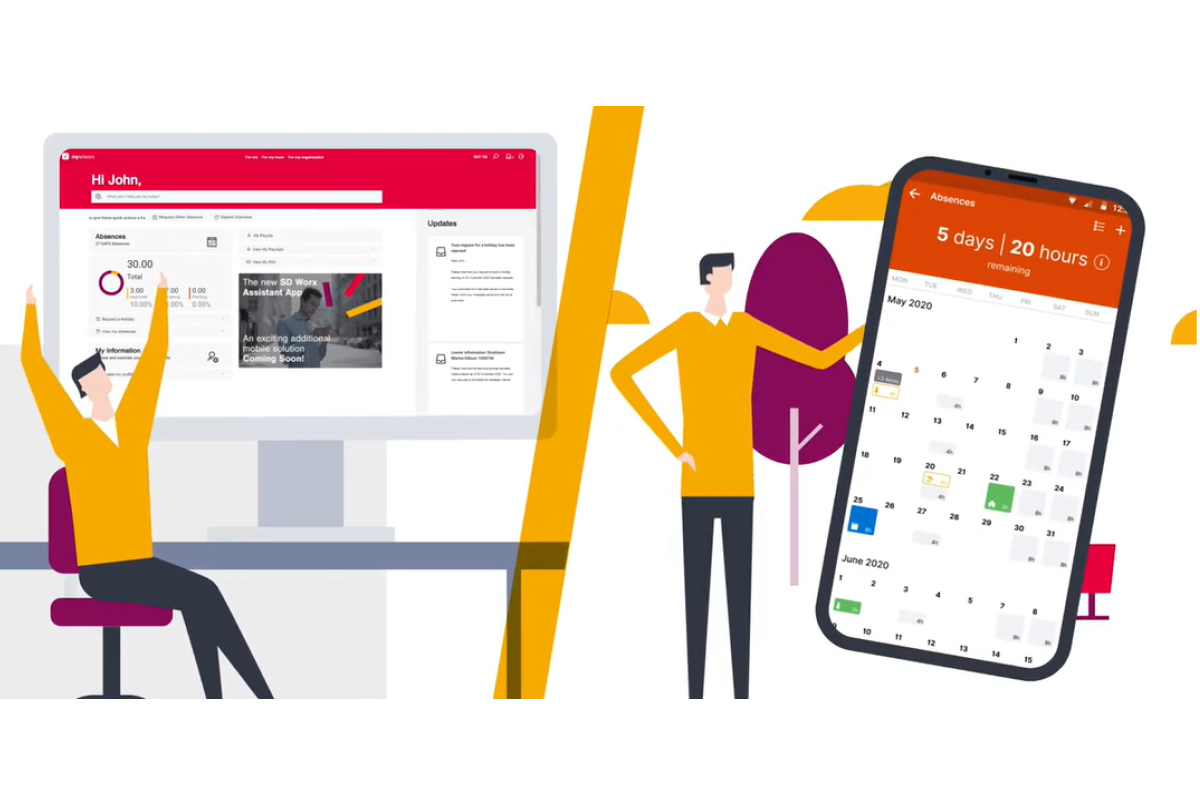
Your guide to integrated Payroll and HR software systems
As HR teams seek to improve employee experiences and enable businesses to bring about people-focused change, operational efficiency has become essential.
These initiatives require solutions that allow HR to act faster and make the best decisions possible. It’s vital, therefore, that menial tasks are automated and key information is always available. This includes payroll data.
Payroll information is crucial to HR as it touches on nearly every element of employment and the employee lifecycle – from recruitment and onboarding, through rewards and retention, to pensions and severances.
To ensure this data is always accessible and is in a format that HR teams are familiar with, it’s necessary to have integrated payroll and HR software systems. The many benefits of integration help HR teams fulfil their strategic goals.
In this guide, we’ll review some of those key benefits, explain how integration works in practice, how organisations can change as a result and what businesses need to consider as they introduce payroll data into other systems.
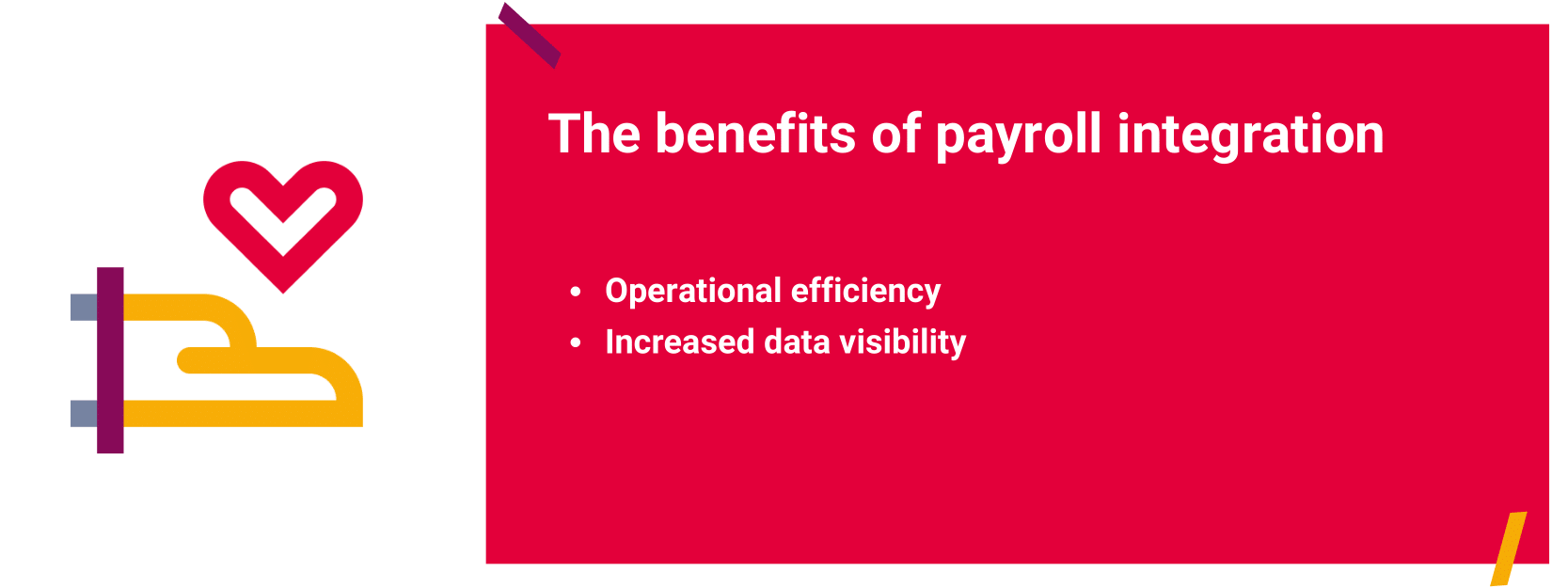
The Benefits Of Payroll Integration
In broad terms, we can break down the main benefits of integration into two parts: operational efficiency and increased data visibility. These benefits enhance HR’s capabilities in many ways.
Operational efficiency
Integration automates the transfer of information from one system to another – so HR teams no longer need to keep multiple systems up to date. For example, when time and attendance data is updated in the HR system, this doesn’t need to be replicated in payroll.
Conversely, if HR needs information from payroll to resolve employee queries it can do this immediately. For example, if an employee wanted to see the impact of a new bonus scheme on a potential severance package, these calculations can be made in almost real-time.
These efficiencies vastly reduce the administrative workload placed on HR departments, offering a new level of operational efficiency that allows HR to focus less on menial tasks and more on strategic objectives.
The integration of systems also enables businesses to facilitate those bigger objectives. For example, with a well-connected digital infrastructure HR can roll out initiatives to achieve a more flexible and fluid working culture. By deploying employee self-serve solutions, for instance, staff can access the information they need and update their details, anytime, anywhere – without the need for manual intervention from the HR team.
Integrated payroll and HR software also helps organisations create digital audit trails that will automatically record where data is held and how it has been processed. This helps businesses comply with regulations, such as GDPR and the UK Data Protection Act, without any additional administration.
Visibility
When payroll data is instantly accessible, HR gain the visibility needed to understand the workforce better and the insights required to bring about people-focused change.
If a global business wants to improve the consistency of employee experience across its organisation, for example, the first step is developing an HR function that has visibility across every country in which it operates.
To access this information, the HR system needs to integrate with numerous payroll engines. This will provide a clear overview of all employees, in every region, allowing HR teams to analyse and interrogate global payroll data.
This enables businesses to develop policies on areas such as recruitment, or reward and retention. It will also help HR provide senior executives with insights that are derived from reliable workforce information.
Integrated payroll and HR software means no conflicting information across different departments, so businesses can base decisions on one single source of truth. And, as data is transferred automatically with less chance of human error, senior executives can be confident the data they are seeing is accurate – giving them the confidence to make crucial decisions.
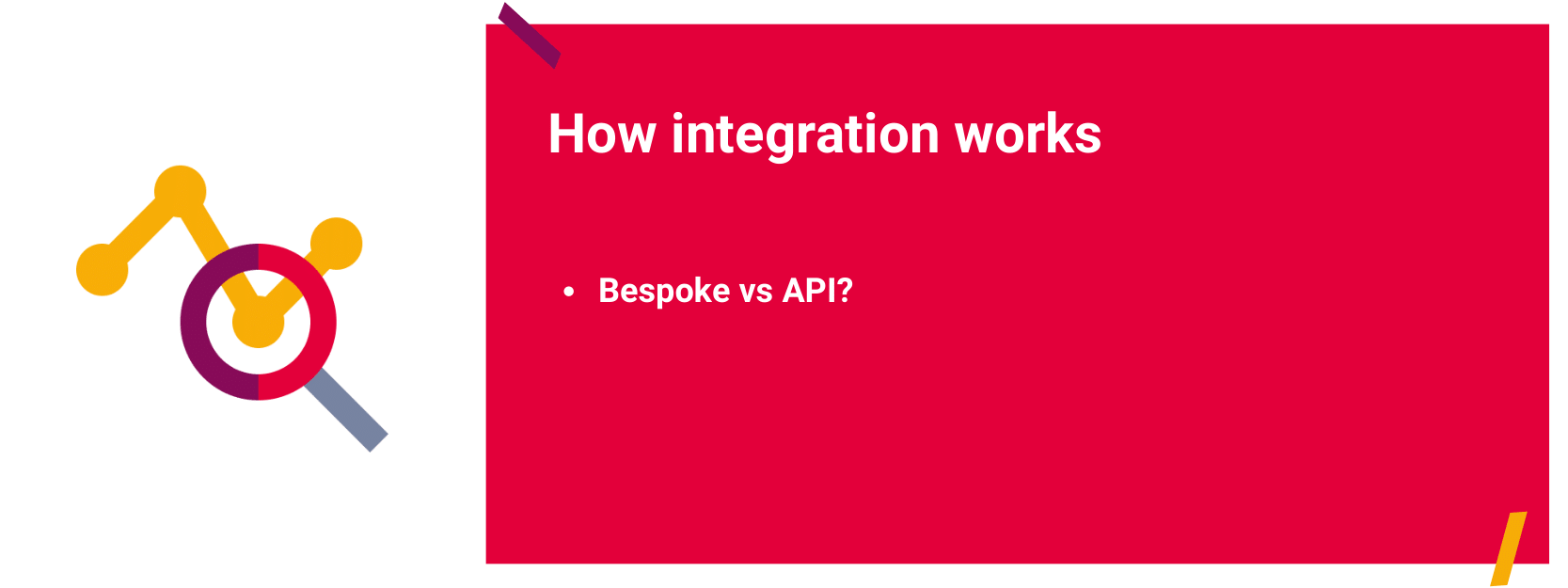
How Integration Works
To populate a HR system with payroll data businesses can either fully integrate their payroll or rely on the traditional approach of a file transfer.
There are benefits to a file transfer. For example, it is easier to send large volumes of data all at once. However, there are also several negatives. Information isn’t updated in real-time, so requests for data take much longer.
File transfers also typically demand more security precautions to protect data in transit. This usually means encryption within an SFTP (secure file transfer protocol) file. These files require recipients to hold the right digital access key to read the information – so should the file end up in the wrong hands there is less chance of a data breach.
An integration removes the risk that a payroll file could end up somewhere it shouldn’t, by providing a permanent connection, with in-built security, between different systems. This also ensures HR staff don’t need to wait for a file transfer to be completed to see the latest information.
Bespoke vs API
A permanent connection between systems will either be enabled by an application programming interface (API) or, if one doesn’t exist, a bespoke integration.
If a business needs to create a bespoke integration, this will usually involve the employment of an integration partner or a specialist development team. The preferable option, however, would be to work with an API, if available.
This provides businesses with a tried and tested solution that is far simpler to manage – and helps them keep their systems up to date.
Before deploying any new HR or payroll software, therefore, companies should check if the new solution has an API and whether it integrates with systems already deployed within the business.
It is also worth checking the level of functionality and data these integrations provide. More advanced solutions will offer more detail on the information passed between systems, including technical information such as error and completion logs.
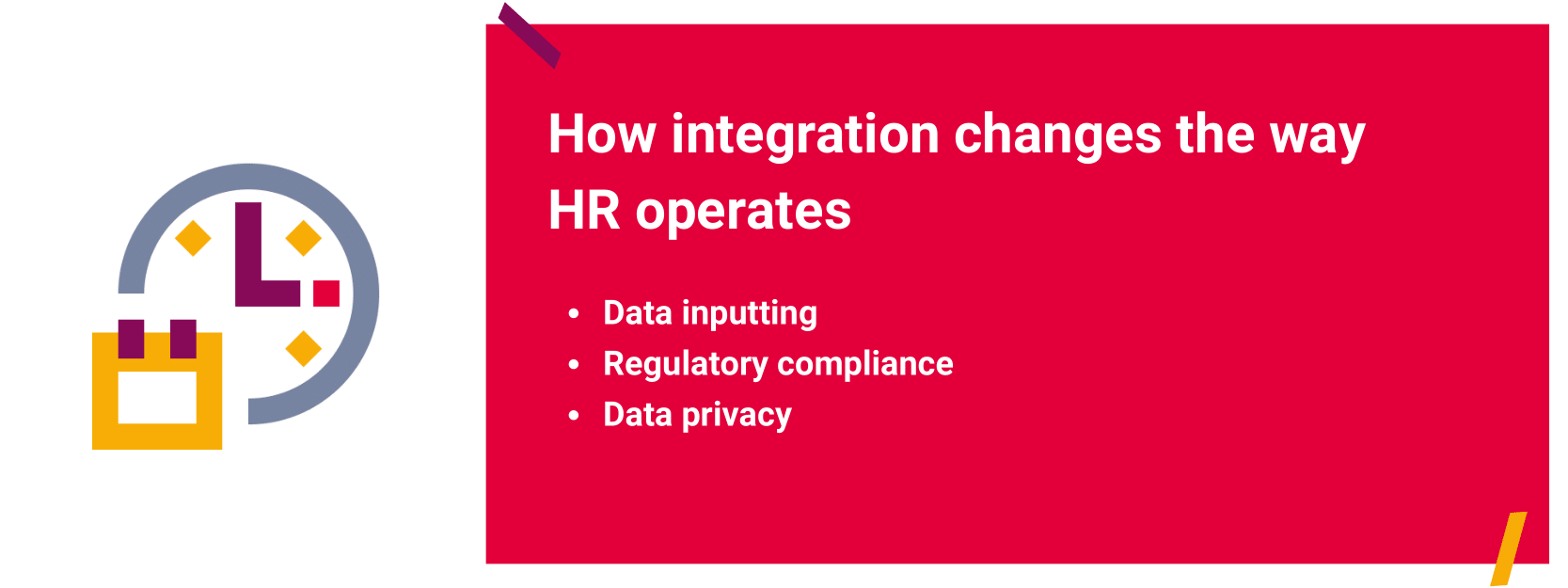
How Integration Changes The Way HR Operates
Integrated payroll and HR software will change the way teams operate in a business. Because an integrated solution isn’t a plug-and-play situation, some behavioural and cultural changes may well be needed.
Businesses will need to review their processes, consider the impact on compliance and take steps to minimise the risk of a data breach.
Data inputting
Firstly, businesses will need to develop processes and protocols that ensure data is being inputted into systems in the right way.
If protocols are not followed, data isn’t in the right format or necessary fields aren’t filled in, it can have significant consequences for end users. Those viewing data in other systems may struggle to understand what they are seeing and won’t be able to conduct meaningful analysis if key information is missing.
It’s essential, therefore, that data inputting is standardised across different departments. As this often requires some behavioural change, it’s often advisable for organisations to seek guidance from a third party experienced in software integrations. The hindsight of numerous integrations across many businesses can be an invaluable resource.
Regulatory compliance
As payroll contains the personal data of employees, businesses must ensure that their organisation remains compliant with regulations, such as GDPR and the UK Data Protection Act, when they integrate their systems. Failure to do so could leave the business facing large fines or reputational damage.
Integration helps businesses with compliance requirements by creating digital audit trails that automatically record where data is stored and how it has been processed.
Businesses should check that any technology partner they work with is also compliant with these regulations and that their solutions help staff follow the right processes. Companies will want to seek reassurances over how data is stored (e.g. where it is held and whether it is encrypted) and whether their business will retain control of their information.
A simple way to evaluate whether a technology partner is reputable is to check what international standards it holds. For example, to ensure compliance with GDPR a good tech provider should hold ISAE 3000. This demonstrates the design and operation of an organisation’s non-financial data processing controls are maintained to a high standard. The equivalent for financial data is ISAE 3402.
SD Worx, which holds both of the above certifications, received these standards after undergoing an external audit from Deloitte to evaluate whether its solutions met ISAE guidelines.
Data privacy
The act of integrating payroll data with systems in other departments will, of course, make it easier for staff to access information. But in so doing, it also exposes private data to more people.
Businesses must, therefore, consider who needs to see that data and then restrict access to only those people. They may also want to extend data privacy protocols that may have previously been limited to the payroll team to cover the HR team too.
Businesses could insist that anyone being granted access to sensitive information also be covered by a non-disclosure agreement. This will help to protect employees’ information and lower the risk that data could be misused or leaked in any way.
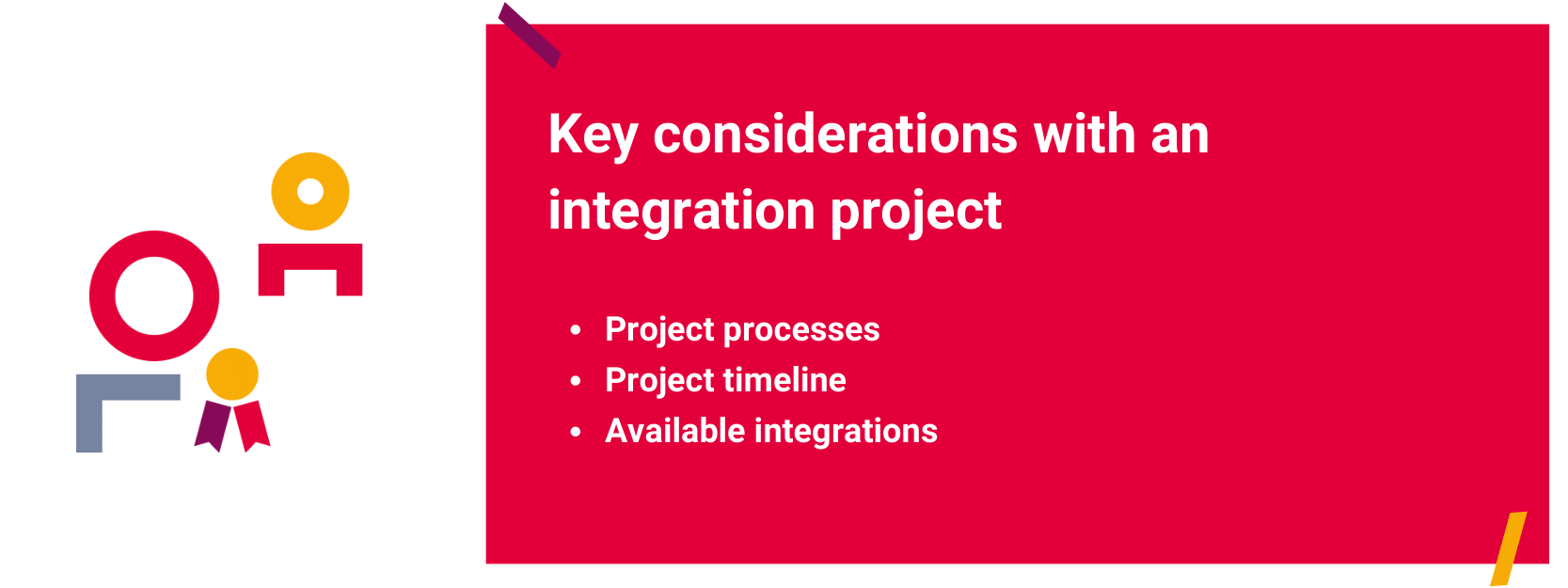
Key Considerations With An Integration Project
Given the benefits of payroll integration, there is a big incentive for businesses to push ahead with these projects. There are some factors to consider before moving forward, however.
For instance, businesses will need a good understanding of the time and costs involved. Exactly how much and how long will depend on several variables, but integration is not something that can happen at the push of a button. These projects can take several weeks.
Key factors influencing the costs and timeline include the actual systems being integrated, whether the integration is a stand-alone project or part of a broader system implementation and the level of engagement with the implementation partner.
Project processes
Any credible integration partner will seek a good level of engagement with the customer, so everyone knows what to expect – helping the project go smoothly.
This process of engagement will typically include a discovery session and an agreement on the course of action, along with the testing and feedback phase before anything goes live.
A stand-alone project
If the integration is not part of a broader implementation rollout, it is likely to be more complex, which will result in the project taking longer and costing more – especially if it’s a bespoke integration.
A bespoke project will not only require the support of a specialist development team or integration partner, but it will also incur the cost of additional software and middleware licenses.
Available integrations
It would be preferable if the payroll supplier had pre-existing integrations with the leading global HR solutions, such as Workday, SAP and Oracle. This can significantly reduce the time, costs and risks involved in an integration project.
Ideally, a payroll supplier would also have its own API that would allow an organisation to connect with other third-party technology providers. This helps to future-proof the business by enabling further transformative digital projects, whenever the organisation wants to deploy new innovative solutions.
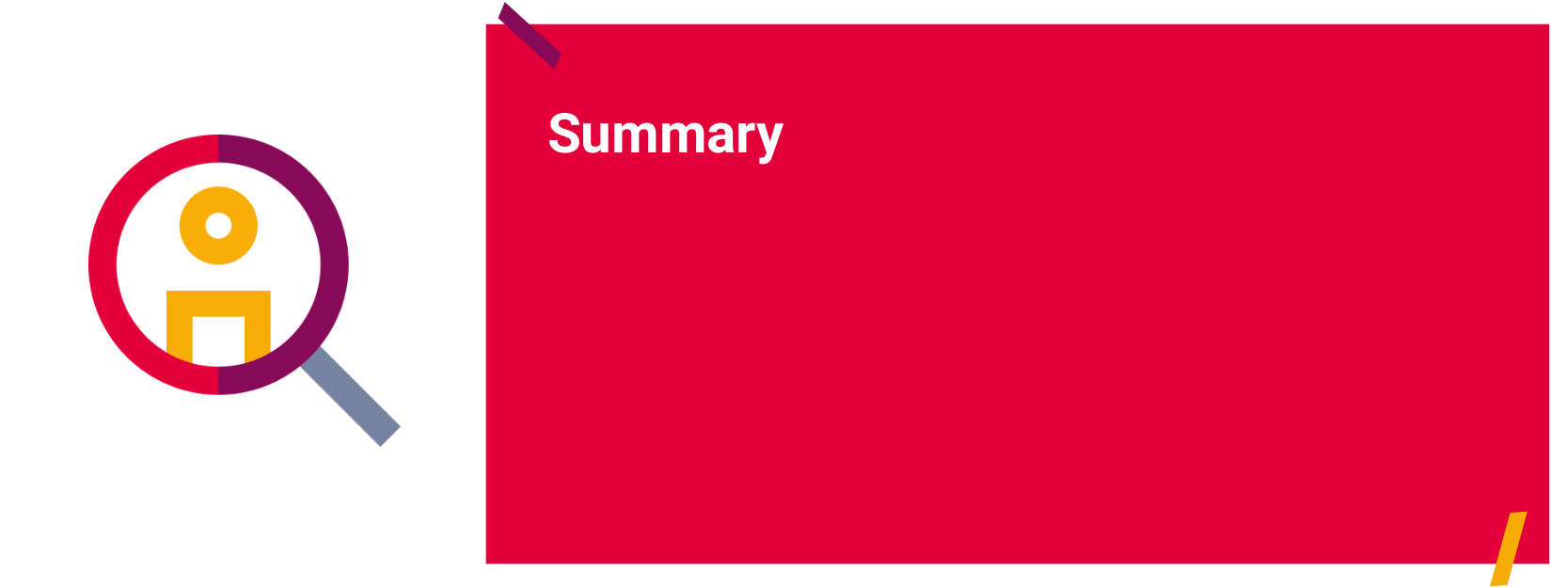
Integrated Payroll And HR Software Systems - Summary
With the traditional methods of transferring data being too slow for modern-day demands, integrated payroll and HR software has become essential for forward-thinking organisations.
The operational efficiencies and increased visibility integration provide enable HR teams to focus more on their strategic objectives and deliver positive change for organisations.
Before embarking on integration, however, organisations need to keep in mind that the process may lead to the introduction of new internal policies and processes to manage data inputting, regulatory compliance and data privacy requirements.
Businesses may also want to review the systems they are choosing to integrate. Are their technology partners reputable (e.g. do they hold the ISAE 3000 standard)? Do they have pre-existing integrations with best-of-breed technology providers? Is there an API that will enable further integrations with other third-party tech providers?
When a business has all the answers it requires and is confident the organisation is ready for the change, however, the time will be right to integrate these systems and enable HR to move forward.
